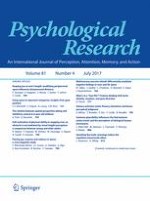17-06-2016 | Original Article
What’s in a “face file”? Feature binding with facial identity, emotion, and gaze direction
Gepubliceerd in: Psychological Research | Uitgave 4/2017
Log in om toegang te krijgenAbstract
A series of four experiments investigated the binding of facial (i.e., facial identity, emotion, and gaze direction) and non-facial (i.e., spatial location and response location) attributes. Evidence for the creation and retrieval of temporary memory face structures across perception and action has been adduced. These episodic structures—dubbed herein “face files”—consisted of both visuo–visuo and visuo–motor bindings. Feature binding was indicated by partial-repetition costs. That is repeating a combination of facial features or altering them altogether, led to faster responses than repeating or alternating only one of the features. Taken together, the results indicate that: (a) “face files” affect both action and perception mechanisms, (b) binding can take place with facial dimensions and is not restricted to low-level features (Hommel, Visual Cognition 5:183–216, 1998), and (c) the binding of facial and non-facial attributes is facilitated if the dimensions share common spatial or motor codes. The theoretical contributions of these results to “person construal” theories (Freeman, & Ambady, Psychological Science, 20(10), 1183–1188, 2011), as well as to face recognition models (Haxby, Hoffman, & Gobbini, Biological Psychiatry, 51(1), 59–67, 2000) are discussed.
